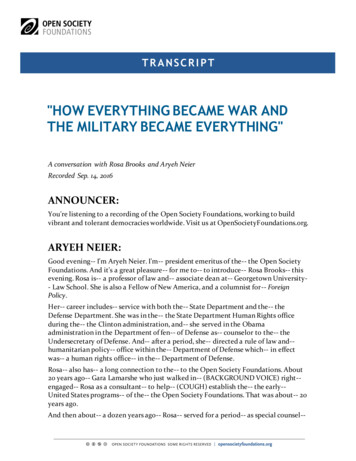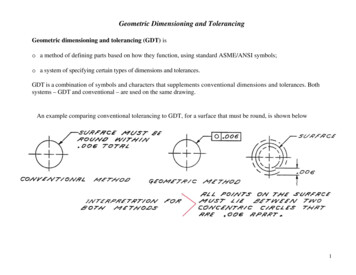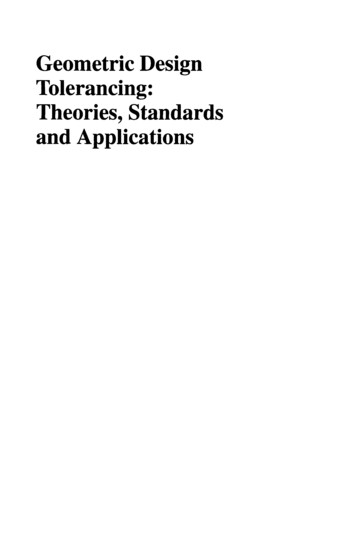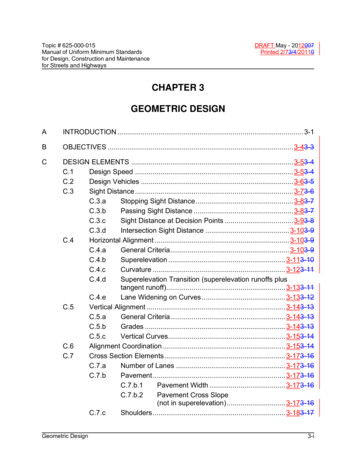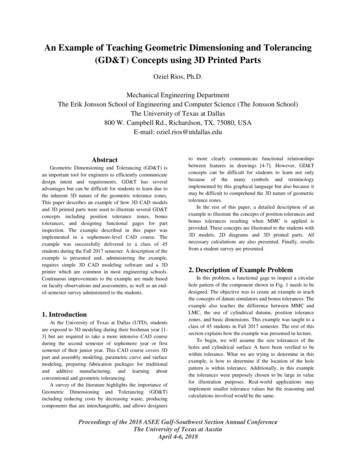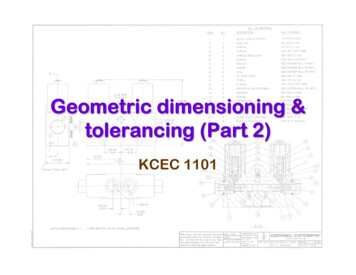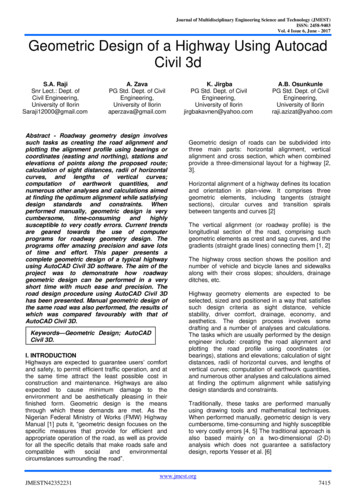
Transcription
Nature’s zoo of elementaryparticles is not a random mishmash; it has striking patterns andinterrelationships that can bedepicted on a diagram corresponding to one of the most intricategeometric objects known tomathematicians, called E8.54 Scientific American, December 2010Photograph/Illustration by Artist Name 2010 Scientific American
A. GarrettLisi bBioalancestimeresearchtheoreticalAuthorText hisuntilanbetween‘end nestedstyle incharacter’(Command 3)physics andan itinerantscientist,is in theofxxxxsurfing.xxxx xxAsxxxxxxxxxx xxxxxxxxxxhexxxxxxxxxprocessxx xxxxxxxxxxxxxxrealizingxxxxxxxxxxa lifelong dream:Pacific Science d on the Hawaiian island of Maui.James Owen Weatherall, having recently completed his doctorate in physicsand mathematics at the Stevens Institute of Technology, is now finishinga second Ph.D. in philosophy at the University of California, Irvine.He also manages to find time to work on a book on the history of ideasmoving from physics into financial modeling.A Geometricp h ys i c sTheory ofEverythingDeep down, the particlesand forces of the universe are a manifestationof exquisite geometryBy A. Garrett Lisi and James Owen WeatherallModern physics began with a sweeping unification: in 1687 isaac Newton showed that the existing jumble of disparate theoriesdescribing everything from planetary motion to tides to pendulums were all aspects of a universal law of gravitation. Unification has played a central role in physics ever since. In themiddle of the 19th century James Clerk Maxwell found thatelectricity and magnetism were two facets of electromagnetism.One hundred years later electromagnetism was unified with the weak nuclear forcegoverning radioactivity, in what physicists call the electroweak theory.This quest for unification is driven by practical, philosophical and aesthetic considerations. When successful, merging theories clarifies our understanding of the universeand leads us to discover things we might otherwise never have suspected. Much of theactivity in experimental particle physics today, at accelerators such as the Large HadronCollider at CERN near Geneva, involves a search for novel phenomena predicted by thein briefIn 2007 physicist A. Garrett Lisi wrote the most talkedabout theoretical physics paper of the year. Outletsfrom the New Yorker to Outside magazine were drawnto the story, partly on account of his surfer lifestyle. Lisiand others have continued to develop the theory.Most physicists think reconciling Einstein’s generaltheory of relativity with quantum theory will require aPhotograph/Illustration by Artist NameIllustrations by Chad Hagen 2010 Scientific Americanradical shift in our conception of reality. Lisi, in contrast,argues that the geometric framework of modern quantum physics can be extended to incorporate Einstein’stheory, leading to a long-sought unification of physics.Even if Lisi turns out to be wrong, the E8 theory he haspioneered showcases striking patterns in particle physics that any unified theory will need to explain.December 2010, ScientificAmerican.com 55
unified electroweak theory. In addition to predicting new physical effects, a unified theory provides a more aesthetically satisfying picture of how our universe operates. Many physicists sharean intuition that, at the deepest level, all physical phenomenamatch the patterns of some beautiful mathematical structure.The current best theory of nongravitational forces—the electromagnetic, weak and strong nuclear force—was largely completed by the 1970s and has become familiar as the StandardModel of particle physics. Mathematically, the theory describesthese forces and particles as the dynamics of elegant geometricobjects called Lie groups and fiber bundles. It is, however, somewhat of a patchwork; a separate geometric object governs eachforce. Over the years physicists have proposed various GrandUnified Theories, or GUTs, in which a single geometric objectwould explain all these forces, but no one yet knows which, ifany, of these theories is true.And an even deeper unification problem faces today’s physicists. In a fully unified theory, gravity and matter should alsocombine naturally with the other forces, all as parts of one mathematical structure—a Theory of Everything. Since the 1980sstring theory, the dominant research program in theoreticalparticle physics, has been an attempt to describe gravity and theStandard Model using elaborate constructs of strings and membranes vibrating in many spacetime dimensions.But string theory is not the only effort. An alternative, loopquantum gravity, uses a more minimal framework, closer to thatof the Standard Model [see “Atoms of Space and Time,” by LeeSmolin; Scientific American, January 2004]. Building on its insights, one of us (Lisi) proposed a new unified theory in 2007.The basic idea is to extend Grand Unified Theories and includegravity as part of a consistent geometric framework. In this unified field theory, called E8 theory, all forces and matter are described as the twisting of a single geometric object.All new ideas must endure a trial by fire, and this one is noexception. Many physicists are skeptical—and rightly so. Thetheory remains incomplete. But even in this early stage of development, it unveils some of the beautiful structures in play at thedeepest levels of nature, and it makes predictions for new particles that the Large Hadron Collider might find. Although physicists are not yet at the culmination of our centuries-long questfor unity, E8 theory is an important step on that journey.EVERY Fiber of Our Beingto describe e8 theory, we first need to set out the widely accepted geometric principles that govern all known forces and particles. Geometry is the study of shape, but in the case of fundamental physics, you might wonder: shape of what? Plato thoughtelements such as earth and air were associated with little cubesand octahedra. Similarly, in modern physics, the geometric objects associated with elementary particles are perfect, smoothshapes, existing outside our space yet connected to it. We cannotsee these shapes directly, but we see their effects.The main geometric idea underlying the Standard Model isthat every point in our space time has shapes attached to it, calledfibers, each corresponding to a different kind of particle. You canenvision the universe as a Chia Pet (a terra-cotta figurine coveredwith sprouts). The surface of the figurine is analogous to space time, and the sprouts are fibers. The entire geometric object—spacetime and fibers together—is called a fiber bundle. The fibers are not in our space, but over it; they may be thought of asdifferent, internal spaces attached to each point of our space time, with shapes corresponding to particles’ properties.This idea, introduced in 1918 by mathematician HermannWeyl, is now a well-established principle of physics [see “FiberBundles and Quantum Theory,” by Herbert J. Bernstein and Anthony V. Phillips; Scientific American, July 1981]. Distinct fromthe speculated undulating spatial dimensions of string theory,these internal space fibers are of fixed shape. Their dynamicsarise from how they are attached to four-dimensional spacetime.The electric and magnetic fields existing everywhere in ourspace are the result of fibers with the simplest shape: the circle.A circle, called U(1) by physicists, is the simplest example of aLie group (pronounced “Lee,” after 19th-century Norwegianmathematician Sophus Lie). It has a single symmetry: if we rotate a circle, it remains the same. A small rotation like this iscalled a generator of the Lie group. Following a generator, justlike drawing with a compass, takes us around a circle.The fiber bundle of electromagnetism consists of circles attached to every point of spacetime [see box on opposite page].Crucially, each circle can rotate a little relative to its spacetimeneighbors. The so-called connection field of a fiber bundle describes how neighboring fibers are related by these symmetryrotations. The electric and magnetic force fields filling space time correspond to the curvature of this fiber bundle—geometrically, the electric and magnetic fields are how the circular fibers twist over time and space. An electromagnetic wave is theundulation of circles over spacetime. One quantum of an electromagnetic wave—a photon—is a propagating particle of light.Each kind of elementary particle corresponds to a different fiber over spacetime; the Chia Pet has many different kinds ofsprouts. All the electrons of the world result from the twisting of asingle kind of fiber—explaining, among other things, why all electrons are identical. The fibers of electrically charged particles, suchas electrons, wrap around the circular fibers of electromagnetism like threads around a screw. How fast a particle’s fiber twistsaround the circle is equal to its electric charge, determining howthe particle responds to the force of electromagnetism.Because twists must meet around the circle, these chargesare integer multiples of some standard unit of electric charge.Of the elementary matter particles, called fermions, electronshave electric charge –1 (three twists), up quarks have electriccharge 2 3 (two opposite twists), down quarks have electriccharge –1 3 (one twist), and neutrinos have 0. The antimatterparticles, such as positrons and antiquarks, have twists in theopposite direction around the electromagnetic circle, givingthem the opposite electric charges.When particles collide, they may be converted into newtypes, but the outgoing particles have exactly the same totalcharge as the incoming ones did. This crucial fact is a consequence of fiber geometry: When any two particles meet, theirtwists add. In this way, the fiber-bundle picture explains whatwe know about electromagnetism. The electric charges describethe geometric structure of the combined electromagnetic andmatter fiber bundle, determining what interactions are possiblebetween electrically charged particles.Different Charges for Different Forcesphysicists apply these same principles to the weak and strongnuclear forces. Each of these forces has its own kind of chargeand its own propagating particles. They are described by more56 Scientific American, December 2010 2010 Scientific American
complicated fibers, made up not just of a single circle but of setsof intersecting circles, interacting with themselves and withmatter according to their twists.The weak force is associated with a three-dimensional Liegroup fiber called SU(2). Its shape has three symmetry generators, corresponding to the three weak-force boson particles: W ,W – and W 3—relatives of the photon. Each Lie group is a multidimensional, smooth tangle of intersecting circles twistingaround one another. The circles of the W and W – bosons inSU(2) twist oppositely around the W 3 circles and so have weakcharge, W, of 1 and –1. Because they have weak charge, theseparticles interact with one another as well as with matter.Exactly half of elementary matter particles interact with theweak force, their fibers twisting around the W 3 and other circlesof SU(2). Fermions come in two varieties, related to how theirspin aligns with their momentum: left-handed and right-handed.Only the left-handed fermions have weak charges, with the lefthanded up quark and neutrino having weak charge 1/2 and theleft-handed down quark and electron having weak charge –1/2.For antiparticles, this is reversed: only right-handed antiparticleshave weak charge. In other words, our universe is not left-rightsymmetrical—we can tell whether we are looking at weak interactions directly or looking at them in a mirror. This asymmetry isone of many mysteries a unified theory seeks to explain.When physicists unified the weak force with electromagnetism to create the electroweak theory, they combined the SU(2)fiber with a U(1) circle. This circle is not the same as the electromagnetic one; it represents a precursor to electromagnetismknown as the hypercharge force, with particles twisting aroundit according to their hypercharge, labeled Y. Inside the combined four-dimensional electroweak Lie group, the W 3 circlescombine with the hypercharge circles to form a two-dimensional torus. This torus can be sliced in many ways, just as every person has their own idiosyncratic way to slice a bagel. The fibers ofparticles known as Higgs bosons twist around the electroweakLie group and determine a particular set of circles, breaking thesymmetry—like someone insisting there is only one true way tocut a bagel. The Higgs does not twist around these circles, whichthen correspond to the massless photon of electromagnetism.Perpendicular to these circles are another set that should correspond to another particle, which the developers of electroweaktheory called the Z boson. The fibers of the Higgs bosons twistaround the circles of the Z boson, as well as the circles of the W and W –, making all three particles massive. Experimental physicists discovered the Z in 1973, vindicating the theory and demonstrating how geometric principles have real-world consequences.A good way to see how the electroweak theory works is to plotthe weak charges and hypercharges of all known particles [seebox on next four pages]. Because mathematicians call charge“weight,” this plot is known as a weight diagram. In this diagram,all particles line up on equally spaced oblique lines, corresponding to their electric charges. Electric charge is thus a specificcombination of weak charge and hypercharge, determined bythe Higgs bosons. By experimentally measuring the strength ofthe weak force, physicists know that the angle of these lines,known as the weak mixing angle, is about 30 degrees. Explainingthe value of this angle is one of the most tangible and immediategoals of a unified theory of physics.Colorful Physicsin the standard model, the strong nuclear force that bindsquarks into atomic nuclei corresponds geometrically to an evenlarger Lie group, SU(3). The SU(3) fiber is an eight-dimensionalinternal space composed of eight sets of circles twisting aroundone another in an intricate pattern, producing interactionsamong eight kinds of photonlike particles called gluons on account of how they “glue” nuclei together. As complicated as thisfiber shape is, we can break it into comprehensible pieces. Em-BasicsFrom Electromagnetism to GeometryThe geometric view of nature follows naturally from the way the worldaround us works. The simplest and most familiar examples are theforces of electricity and magnetism. Electric sparks, magnetic attraction and laser light are different manifestations of the electric and mag-netic fields that pervade space. In fact, physicists think that everything inthe world—all the forces of nature and even all the particles of matter—arises from different kinds of fields. The behavior of these fieldshints at an underlying geometric cfieldElectron fiberConnectionfieldacbA laser beam (a) consists of oscillating electric and magnetic fields (b), which are themanifestations of a single electromagnetic “connection” field (c). This field describeshow circular "fibers" of electromagnetism twist across the beam. That is, a circulardefiber is attached to every point in spacetime, and a particle of light (a photon)corresponds to the undulation of these circles (d). A charged particle such as anelectron corresponds to another fiber that wraps around the circular fiber (e).December 2010, ScientificAmerican.com 57 2010 Scientific American
bedded within it is a torus formed by two sets of untwisted circles, corresponding to two generators, g3 and g8. The remainingsix gluon generators twist around this torus, and their resultingg3 and g8 charges form a hexagon in the weight diagram.The quark fibers twist around this SU(3) Lie group, theirstrong charges forming a triangle in the weight diagram. Thesequarks are whimsically labeled with three colors: red, green andblue. A collection of matter fibers forming a complete pattern,such as three quarks in a triangle, is called a representation ofthe Lie group. The colorful description of the strong interactions is known as the theory of quantum chromodynamics.Together, quantum chromodynamics and the electroweakmodel make up the Standard Model of particle physics, with aLie group formed by combining SU(3), SU(2) and U(1), as well asmatter in several representations. This structure is described bya weight diagram with four charge axes, which may be projecteddown to two dimensions and plotted. This diagram displays thecrown jewels of modern physics. Every allowed particle interaction of the Standard Model may be found on it.The Standard Model is a great success. But it presents severalpuzzles: Why does nature use this combination of Lie groups?Why do these matter fibers exist? Why do the Higgs bosons exist?Why is the weak mixing angle what it is? How is gravity included? And there are other mysteries we have not even touched on.The quarks, electrons and neutrinos that constitute commonmatter are called the first generation of fermions; they have second- and third-generation doppelgängers with identical chargesbut much larger masses. Why is that? And what are cosmic darkmatter and dark energy? A unified theory should be able to provide answers to these and other questions. The first step towardsuch a theory is the unification of electroweak and strong forces.Grand (But Not Full) Unificationalthough the electroweak and strong forces can both be described using fiber bundles, their fibers are separate. Physicistshave asked whether some single fiber encompasses both. Insteadof different Lie groups for each force, there would be a single,larger Lie group for all. They have good evidence for this idea: allthese forces become close in strength at very short distances, indicating they are aspects of a single force. A Grand Unified Theory would describe this force, reproduce the Standard Model andmake testable predictions.In this way, investigators are trying to reproduce the earliersuccess of finding why the chemical elements line up in the periodic table, representing the structure of atoms. Once chemistshad gleaned this structure, they began making predictions forwhat properties the elements should have and what new elements might await discovery. Likewise, particle physicists todayare trying to find out why the weight diagram of the StandardModel has the pattern it does, and once they do, they will beable to make predictions for what properties the particlesshould have and what new particles might exist.The first attempt at such a theory was proposed in 1973, byHoward Georgi and Sheldon Glashow [see “A Unified Theory ofElementary Particles and Forces,” by Howard Georgi; ScientificAmerican, April 1981]. They found that the combined Lie groupof the Standard Model fits snugly into the Lie group SU(5) as asubgroup. This SU(5) GUT made some distinctive predictions.First, fermions should have exactly the hypercharges that theydo—a highly nontrivial success. Second, the weak mixing angleshould be 38 degrees, in fair agreement with experiments. Andfinally, in addition to the 12 Standard Model bosons, there are 12new force particles in SU(5), called X bosons.d i a g r a m s o f pa r t i c l e c h a r g e sA Progression of TheoriesEach type of elementary particle corresponds to a different fiber. These fibers twistaround the various circular fibers of photons and other force particles; the twistingcorresponds to their electric and other charges, which mathematicians call “weights.”Each force of nature has its own type of charge and is mediated by its own force particles. The patterns of particles’ charges describe the geometry of how the fiberstwist around one another, governing how the corresponding particles can interact.BOSONSY0 W 1 ⅔ ⅓0FERMIONSW–⅓PhotonNeutrinoLeft-handed spin-upWeak bosonsElectronLeft-handed spin-downGluonsUp quarkRight-handed spin-upGravitonsDown quarkRight-handed spin-downFrame-HiggsUp quarkRight-handed spin-up antiWeaker bosonsDown quarkRight-handed spin-down antiX bosonsUp quarkLeft-handed spin-up antiMore HiggsDown quarkLeft-handed spin-down antiThe world of elementary particles is a veritable menagerie. Particles come in two broad types, bosons(which transmit forces) and fermions (which constitute matter). Each fermion can come in severalvarieties: particle or antiparticle, left- or right-handed, spin up or down, and, for quarks, one of threecolors. Every particle, identified by its charges, can be plotted in a weight diagram.58 Scientific American, December 2010 2010 Scientific American–⅔–1Electroweak Theory. Electromagnetism and the weak nuclear forceemerge from the unified electroweak force. On its weight diagram,physicists plot particles by their hypercharge (Y) and weak nuclearcharge (W). Higgs bosons (partially hidden gray squares) lie on an obliqueline running from top the left to bottom right, defining zero electriccharge. Electrically charged particles lie on parallel lines. In this way,electric charge is a specific amalgam of hypercharge and weak charge.
It was the X bosons that got the theory into trouble. Thesenew particles would allow protons to decay into lighter particles, which they cannot do in the Standard Model. In impressiveexperiments, including the observation of 50,000 tons of waterin a converted Japanese mine, the predicted proton decay wasnot seen. Thus, physicists have ruled out this theory.Despite the SU(5) theory’s failures, its successes suggest thattheorists are generally on the right track. A related Grand Unified Theory, developed around the same time, is based on the Liegroup Spin(10). It produces the same hypercharges and weakmixing angle as SU(5) and also predicts the existence of a newforce, very similar to the weak force. This new “weaker” force,mediated by relatives of the weak-force bosons called W ' , W '–and W '3, interacts with right-handed fermions, restoring leftright symmetry to the universe at short distances. Although thistheory predicts an abundance of X bosons—a full 30 of them—italso indicates that proton decay would occur at a lower rate thanfor the SU(5) theory. So the theory remains viable.Drawn a certain way, the weight diagram for the Spin(10)GUT shows that particle charges align in four concentric circles—an unusually pretty pattern [see left panel on next page].The balance evident in this diagram arises for a deep reason:the Spin(10) Lie group with its 45 bosons, along with its representations of 16 fermions and their 16 antifermions, are in factall parts of a single Lie group, a special one known as the exceptional Lie group E6.The exceptional groups play an exalted role in mathematics.Because there are only so many ways circles can twist aroundone another, there are only a handful of different kinds of Liegroups. Mathematicians completed their classification a century ago. We have already met two, SU and Spin, encounteredquite often in physics. And among the Lie groups there are fiveexceptional cases that stand out: G2, F4, E6, E7 and E8. TheseLie groups have especially intricate structures and deep connections to many areas of mathematics.The fact that the bosons and fermions of Spin(10) and theStandard Model tightly fit the structure of E6, with its 78 generators, is remarkable. It provokes a radical thought. Up until now,physicists have thought of bosons and fermions as completelydifferent. Bosons are parts of Lie group force fibers, and fermions are different kinds of fibers, twisting around the Lie groups.But what if bosons and fermions are parts of a single fiber? Thatis what the embedding of the Spin(10) GUT in E6 suggests. Thestructure of E6 includes both types of particles. In a radical unification of forces and matter, bosons and fermions can be combined as parts of a superconnection field.Although several people have criticized this idea because itcombines fermions and bosons in a way that at first appears fundamentally inconsistent, it relies on solid mathematics. And thecurvature of this superconnection, describing the twisting of E6over spacetime, succinctly describes the dynamics and interactions of bosons and fermions in the Standard Model. But E6does not include the Higgs bosons or gravity.taking gravity for a spinalbert einstein originally described gravity as the curvature ofspacetime. His mathematical machinery was state-of-the-art atthe time, but researchers have gradually adopted a more modern, equivalent description of gravity based on a fiber bundle.At every spacetime point, we can imagine three perpendicularrulers and a clock, called a frame of reference. Without the frame,spacetime would not be “spacetime” but just a four-dimensionalg8YYWg8g3Strong Nuclear Force. The eight gluons (six in a hexagon,two overlapping in the middle) that mediate the strongforce interact with one another, quarks and antiquarksaccording to their strong-force charges (g3 and g8). Threequarks, one of each color, sit in a triangular pattern. Whenparticles interact, such as the circled gluon interacting witha green quark to make a red quark, charges must balance.0 WWg8g3Standard Model. Combining the weight diagrams of theelectroweak and strong forces yields the Standard Modelof particle physics—the prevailing theory of the naturalworld. The full four-dimensional diagram is flattened to fiton the page. All nongravitational particle interactionscorrespond to balancing charges in this diagram. A majorgoal of contemporary physics is to explain this pattern.g3Grand Unified Theory. The electroweak and strongforces might be parts of a larger structure, such as thefiber shape called SU(5), with a pattern shown here.This shape has 12 new particles called X bosons, whichallow a proton (two up quarks and a down quark,circled) to change into a positron (antielectron) anda pion (up quark and anti-up-quark pair).December 2010, ScientificAmerican.com 59 2010 Scientific American
fabric with no sense of orientation or distance. As we move to different points in spacetime, there are different sets of rulers andclocks, related to our original frame by a rotation. This rotationcan be an ordinary rotation in space or, because Einstein showedthat space and time are unified, a rotation of space into time. Howthe frame rotates from point to point is determined by the spinconnection, more commonly known as the gravitational field.The Lie group of possible rotations in three spaces and one timedirection is Spin(1,3)—the Lie group of gravity. We feel the forceof gravity because the gravitational spin connection field is rotating our frame as we move through time, attempting to steer ustoward Earth’s center.Just as particles have different kinds of charge describing howthey interact with Standard Model forces, they have a type ofcharge describing how they behave within space. Consider whathappens if we rotate a ruler in space by 360 degrees: it returns toits original state. This ruler—and the gravitational frame field—has spatial spin charge of 1 or –1. But if we rotate a fermion, suchas an electron, in space by 360 degrees, it does not return to thesame state it started in. To return it to its original state, we have torotate it by 720 degrees. The fermion has spin charge of 1/2.Spin charge plays a role in gravity because gravity, throughthe frame and spin connection, is related to the geometry ofspace time. As we did for the other forces, we can make a weightdiagram for gravity based on spin [see center panel below]. Aparticle’s spatial spin charge is its internal angular momentum,and its temporal spin charge is related to its motion throughspace. Fermions whose spatial spin and motion align, plotted inthe upper right or lower left of the diagram, make a right-handed corkscrew as they travel through space. Fermions with opposite motion and spatial spin are left-handed.What is strange is that spin charge also has an unexpectedrelevance to the weak nuclear force. Only left-handed particlesand right-handed antiparticles have weak charge and interactwith the weak force. The fact that the weak force is sensitive tospin charge suggests that gravity and the other forces, thoughoutwardly dissimilar, in fact have a deep relationship.E Pluribus Unumnow it is just a matter of putting the pieces together. With gravity described by Spin(1,3) and the favored Grand Unified Theorybased on Spin(10), it is natural to combine them using a singleLie group, Spin(11,3), yielding a Gravitational Grand UnifiedTheory—as introduced last year by Roberto Percacci of the International School for Advanced Studies in Trieste and FabrizioNesti of the University of Ferrara in Italy. It brings us close to afull Theory of Everything.The Spin(11,3) Lie group allows for blocks of 64 fermions and,amazingly, predicts their spin, electroweak and strong chargesperfectly. It also automatically includes a set of Higgs bosons andthe gravitational frame; in fact, they are unified as “frame-Higgs”generators in Spin(11,3). The curvature of the Spin(11,3) fiber bundle correctly describes the dynamics of gravity, the other forcesand the Higgs. It even includes a cosmological constant that explains cosmic dark energy. Everything falls into place.Skeptics objected that such a theory should be impossible. Itappears to violate a theorem in particle physics, the ColemanMan dula theorem, which forbids combining gravity with the other forces in a single Lie group. But the theorem has an importantloophole: it applies only when spacetime exists. In the Spin(11,3)theory (and in E8 theory), gravity is unified with the other forcesonly before the full Lie group symmetry is broken, and when thati Ti TYXWg8Sg3E6 Theory. An even grander unification idea is thatnot just the forces of nature but also the particles ofmatter are all parts of a single fiber shape. In fact, ashape kn
objects called Lie groups and fiber bundles. It is, however, some-what of a patchwork; a separate geometric object governs each force. Over the years physicists have proposed various Grand Unified Theories, or GUTs, in which a single geometric object would explain all these forces, but no one yet knows which, if any, of these theories is true.
